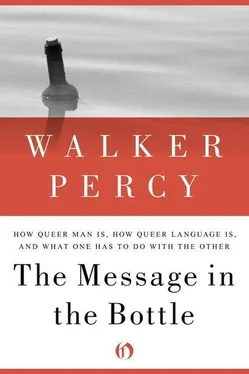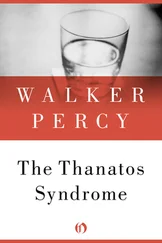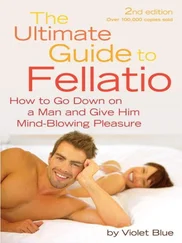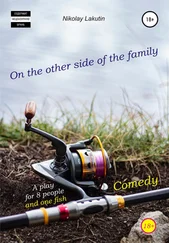* It is this transformation of symbols and their subsequent confusion with things that Count Korzybski used to rage against. “Whatever you choose to say about this object,” he would say, holding a pencil aloft, “don’t say ‘this is a pencil.’ “ “Whatever you say the object ‘is,’ well it is not” (p. 35).
In point of fact, I have never seen anyone mistake a word for a thing or try to write with the word pencil, though the magic use of words undoubtedly occurs in primitive societies and perhaps an analogous misuse in modern technological societies.
Korzybski tended to treat the peculiar features of symbol use as misbehavior to be gotten rid of by a therapeutic semantics which was almost an ethical science.
In a triadic theory of meaning it is to be hoped that symbolic transformations and sentence couplings with the verb is will not be put down as instances of bad behavior or human stupidity but rather will be regarded as a fundamental property of sentence utterance.
What needs to be explored is not human perversity as such but rather a parameter variable of symbol use. All sentences entail couplings. The mode of coupling is a normative dimension in which couplings may be used truly or falsely in propositions, well or badly in poetry, as a transparent vehicle of meaning or as an opaque simulacrum which distorts meaning.
† Werner and Kaplan note that the word chair is not merely a sign or label for chairs: “…the material, phonemically unique sequence, ch-ai-r, is articulated into a production whose expressive features parallel those ingredients in the percept ‘chair.’…Only when the vocable has become imbedded in an organismic matrix, regulated and directed by an activity of schematizing or form-building, does it enter into a semantic correspondence with the object (referent) and does it become transformed from the status of a sign to that of symbolic vehicle.”
* Cf. Braine: He and others have noted that an early stage of language acquisition in children features two-word utterances comprising a “pivot” word and an “open” word. Thus a child using the “pivot” word there might combine it with any number of “open” words and say there ball, there man, there doggie, etc. Then in a few months a second stage is reached in which the child combines two “open” words. Thus instead of saying there car or there man, the child might say man car, meaning “A man is in the car.”
Braine noted a pause or juncture between the two “open” words. Thus baby chair or baby book, uttered without a juncture, is presumably a pivot-open construction meaning “(There is) a little chair” or “(There is) a little book.” Whereas the utterance baby#chair, uttered in a certain context, is reliably understood by the mother to mean “The baby is in his chair.” The symbol # represents a juncture or pause.
This open-open construction is a very large class and represents, to my way of thinking, nothing less than the child’s graduation from the naming sentence (there ball) to the syntactical, “subject-predicate” sentence.
Let us agree with Chomsky that a child’s linguistic behavior cannot possibly be accounted for by traditional learning theory with its notions of “stimulus control,” “conditioning,” “generalization and analogy,” “patterns,” “habit structures,” or “dispositions to respond.”
The question, however, is whether the sole alternative to learning theory is Chomsky’s “innate ideas and innate principles,” specifically in this case a “language acquisition device,” a kind of magic black box interposed between input and output which contains not only the principles of universal grammar but the capacity of generating the grammar of one’s own language.
I wonder whether Chomsky’s LAD (language acquisition device) is nothing more nor less than the unique human ability to couple sentence elements, to couple symbols with things, symbols with symbols, which couplings may be understood to mean whatever context allows them to mean.
Indeed, may not grammar itself be defined as the primitive coupling plus whatever inflection, particles, and patterns may be required to supplant the diminishing context and the intuitive grasp by the mother of the child’s couplings? Thus the child’s sentence baby#chair may be understood infallibly by the mother to mean The baby is now in his chair. But as the intimate mother-child relationship declines and as it becomes necessary for people to talk to strangers over telephones about
babies and chairs which at least one party cannot see, it becomes necessary to add such words as the, is, in, his, etc.
If one must speak of a universal grammar, it is surely impossible to avoid the basic phenomenon of the sentence as a coupling and the basic division of couplings into two sorts, whether the language be English or Algonquin: (1) an object beheld by both speaker and hearer and pointed at and understood as one of a class of like objects and named by a sound which is understood as a class of like sounds — thus the pointing at and the utterance of the single-word sentence by father to son: balloon. (2) the coupling of symbol and symbol, e.g., baby#chair to signify vvhatever world relation or event is beheld in common by speaker and hearer.
* According to Veatch, mathematical logicians habitually confuse logical relations with “real” relations — here we would say sentence relations with world relations. Veatch calls the sentence coupling “an intentional relation of identity.” Thus the relation of John to Bill asserted in the sentence John is larger than Bill is a world relation which can be expressed by the isomorphic form x R y . Mathematical logicians persist in setting forth the sentence in the form x R y, whereas in truth the sentence relation is of the form S is P.
Lord Russell and the early Wittgenstein of the Tractatus believed that the sentence must be in some sense isomorphic with the fact asserted by the sentence. The later Wittgenstein changed his mind and came to believe that sentences were plays in a language game and could mean whatever they were used to mean.
* Transactions between analyst and patient are especially open to sudden shifts of context, missing referring words, uncued worlds, since the rules of this language game require the patient to say “what comes to mind.”
† Here again, the uncritical use of analogical terms has impeded inquiry into distinctively human modes of meaning. Thus, when instrumentalists like Dewey describe scientific research as socially useful activity like farming and marketing, they state a not very interesting similarity at the expense of a much more interesting difference. What concerns us here is how the farmer sees himself vis-à-vis the world, and how the scientist sees himself. The two are not necessarily the same.
More interesting still is how the layman sees himself vis-à-vis the world of science. Is it possible, for example, for a layman to benefit in one sense from the goods and
services of scientific technology while in another sense falling prey to them, e.g., coming to see himself as a consumer of these same goods and services as a passive beneficiary of a more or less esoteric, not to say magic, enterprise? “They will soon come up with a cure for cancer,” one hears. The question is, Who is “they,” and how does the speaker see himself in relation to “them”?
* Here I am making the case that sentence utterances are triadic events about dyadic events. My utterance Sodium reacts with water is a triadic event about a dyadic event.
Читать дальше












